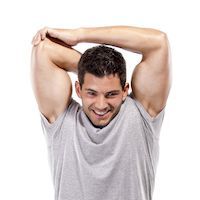What is progressive muscle relaxation (PMR)?

Progressive muscle relaxation is a form of relaxation therapy. PMR involves tightening and relaxing groups of muscles in a special order with coordinated breathing. PMR helps you notice the areas where you hold tension in your body. After noticing the tension, you will learn to relax these areas and restore balance in your muscle groups.
What does progressive muscle relaxation help?
Progressive muscle relaxation can help:
- Depression
- Tiredness
- Anxiety/stress
- Improve memory and concentration
- Improve immune system
- Improve physical healing
How does it work?

When your body is stressed, it needs to be ready for anything. Muscles will get tense and your heart with beat quickly- this is your body getting ready to face danger. Over long periods of stress your body forgets to relax these muscles. PMR helps your muscles relax again, reminding them how to let go. You might be surprised to feel muscles relax that you didn't even realize were tight!
How do I do progressive muscle relaxation?
Here is a basic outline of how to do PMR:
- Find a quiet place where you can sit or lie comfortably.
- You are going to be tensing muscles one group at a time. In general, try to take a deep breath through your nose as you tighten. As you relax, breath out slowly like you are breathing through a straw.
- Relax the muscle group completely. Take a deep breath in and out, feeling how relaxed the muscles are, then move onto the next group.
- Toes: curl your toes tightly and hold for 3-5 seconds.
- Feet and legs: Point your toes toward the floor, feel your calves and the arches of your feet tighten.
- Feet and legs, part 2: Flex your feet, pointing your toes toward your head. Feel the fronts on your legs tighten.
- Thighs: Squeeze your buttocks together, you will feel tightness in your lower back as well.
- Stomach: Curl your stomach by sucking your belly button toward your back, feel the tightness in the front of your body
- Back and Chest: Squeeze your shoulder blades together, and arch your back, feel your whole back tighten. You might also feel tightness in your chest.
- Hands: make tight fists, feel the tightness in your forearms and hands.
- Front arms: Curl your fists toward your shoulders, feel the tightness in your forearms and upper arms and the front of your shoulder
- Back arms: extend your arms completely, open your hands like you are telling someone to "stop". Feel the tightness in forearms and the backs of your upper arms and shoulders.
- Shoulders and neck: Raise shoulders up to ears as far as they can go and feel the tightness in your inner shoulders and outer neck muscles.
- Around the mouth and eyes: Smile as widely as you can while pressing your tongue to the roof of your mouth; clench your eyes tight and feel the tension in your face, including the top of the nose.
- Forehead and scalp: elevate forehead as high as possible; appreciate tension in forehead and scalp.
- Finally, take a few deep breaths in and out to feel the relaxation in your body. Return to normal by slowly counting down from 5 to 1.
You can listen to an example of a recorded PMR session here:
- You can listen to an example of a recorded PMR session here
- In Spanish
Is it expensive? Do I need to go anywhere to do it?
With handouts and online recordings, PMR is free. You can do it wherever and whenever you want!
How often should I do it?
For the first week or two, practice this exercise twice a day for 10-20 minutes.until you get the hang of it. After you get the hang of it, practice 1-3 times per week or whenever you need it. The more you do it, the quicker your muscles will respond.
Are there any risks?
PMR is totally safe.
Print Version
References/Resources
For more information visit:
National Center for Complementary and Integrative Health
Resources:
Bain E. et al. Interventions for managing asthma in pregnancy. Cochrane database of systematic reviews, 2014 Issue 10.
Hassanpour-Dehkordi A & Jalali A, Effect of Progressive muscle relaxation on the Fatigue and Quality of Life among iranian aging persons. Acta Med Iran 2016 Jul;54(7): 430-6
Hubbard k Blyler D, Improving Academic Performance and working memory in health science graduate students using progressive muscle relaxation training. American Journal of Occupational therapy, Oct 2016; 70:6
Jorm AF. Morgan AJ, Hetrick SE. Relaxation for depression. Cochrane database of Systematic reviews 2008, issue 4.
Lolak S, Connors G L, Sheridan, M J et al. Effects of Progressive Muscle Relaxation Training on Anxiety and Depression in Patients Enrolled in an Outpatient Pulmonary Rehabilitation Program. Psychotherapy and Psychosomatics, Feb 2008; 77(2):119-25·
Nickel C, Lahmann C et al. Pregnant women with bronchial asthma benefit from progressive muscle relaxation: a randomized, prospective, controlled trial. Psychotherapy and Psychosomatics. 2006;75:237-43
Smith, Jonathan C. Relaxation, meditation, & mindfulness: A mental health practitioner's guide to new and traditional approaches. Springer Publishing Company, 2005.
Vancampfort D, Correll CU, Scheewe TW et al. Progressive muscle relaxation in persons with schizophrenia: a systematic review of randomized controlled trials. Clinical rehabilitation. 27(4) 291-98
Zargarzadeh M, Shirazi M. The effect of progressive muscle relaxation method on test anxiety in nursing students. Iranian journal of nursing and midwifery research, Nov 2014; 19(6):607-12.
http://www.uwhealth.org/health/topic/special/muscle-relaxation/ta4146.html
Patient Education Materials
- Acupuncture
- ADHD
- Allergic Rhinitis
- Anxiety
- Aromatherapy
- Asthma
- Autism
- Back Pain
- Biofeedback Therapy/Training
- Breathing Techniques
- Cancer Symptoms
- Chiropractic
- Constipation
- Depression
- Diabetes
- Dyslipidemia
- Eczema
- Elimination Diet
- Fibromyalgia
- GERD
- Headache
- Healthy Diet
- Healthy Weight / Obesity
- Heart Disease
- High Blood Pressure
- Inflammatory Bowel Disease
- Insomnia
- Irritable Bowel Syndrome (IBS)
- Massage Therapy
- Meditation
- Menopause
- Menstrual Disorders
- Osteoarthritis
- Physical Activity
- Probiotics
- Rheumatoid Arthritis
- Supplements
- Tai Chi
- Yoga